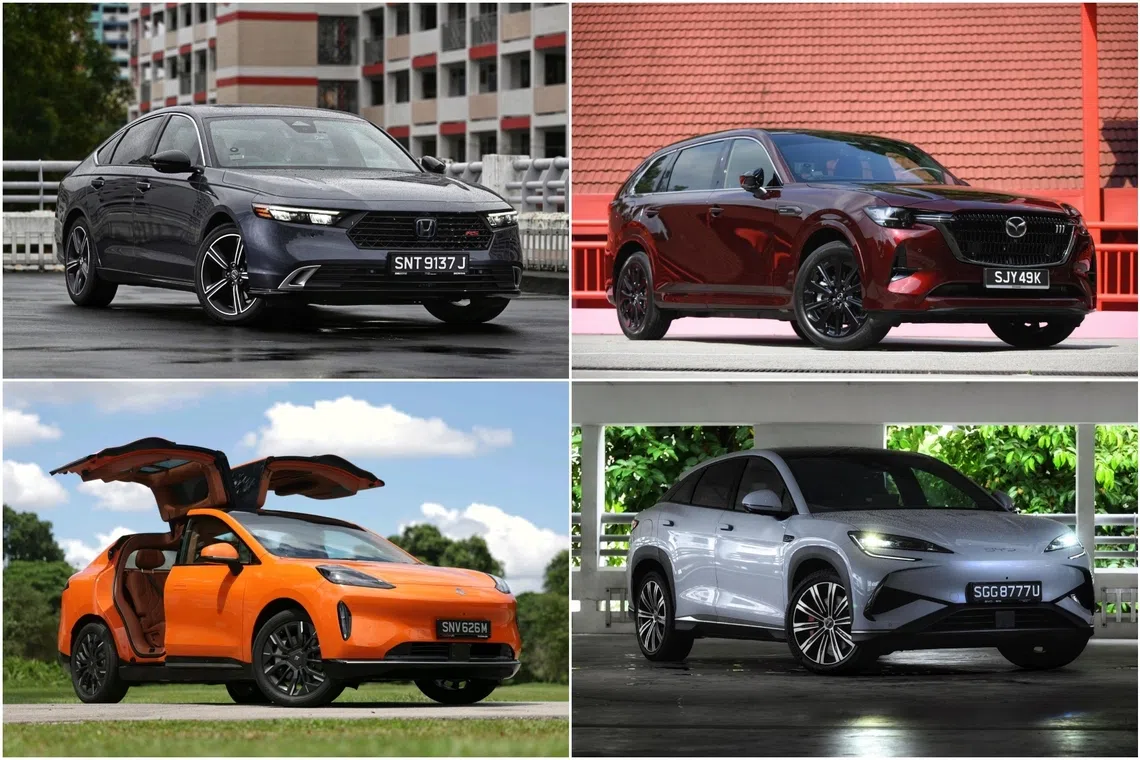2025 ST Car of the Year mid-year scorecard
Sign up now: Get ST's newsletters delivered to your inbox

(Clockwise from top left) The Honda Accord, the Mazda CX-80 and Chinese EVS BYD Sealion 7 and the Hyptec HT.
ST PHOTOS: CHONG JUN LIANG, MARK CHEONG, KEVIN LIM
Follow topic:
SINGAPORE – New cars launched in the 12 months up till November are in contention for the annual Straits Times Car of the Year (Coty) Award. May marks the midway point and it is a good time to take stock.
Between December 2024 and May 2025, the Motoring section featured 37 local car reviews, consisting of 24 new models. The rest were facelifts or variants of existing models.
So, what have we seen from the class of 2024/2025 so far and what is to come?
1. EVs, especially Chinese ones, dominate
There were 19 electric vehicles (EVs) among the cars reviewed, with 14 of them from Chinese carmakers.
Then there are EVs like the Tesla Model Y and Mini Aceman, which may not be Chinese brands, but are built in China.
Beyond their attractive price tags and generous list of standard luxury features, the Chinese EVs also seem to be really energy-efficient. Many of the EVs tested managed to post better-than-average energy consumption figures than claimed.
Among those EVs reviewed are 11 that come from brands which have not been in Singapore for more than a year.
Deepal and Jaecoo, for example, were launched as recently as January. And if you cannot tell an Aion from a Skyworth or a Dongfeng, things are about to get even more confusing in the coming months.
More brands are going to open shop in Singapore, like Leapmotor, which is a Chinese brand with backing from Stellantis, a global auto group with brands like Alfa Romeo and Peugeot.
With more brands and more dealers in the game, it will be difficult for the premiums for certificates of entitlement (COEs) to come down as everyone jostles for prominence, while the existing ones fight for survival.
2. Plenty of cars with three out of five stars

The Volvo XC90 was just one point away from getting a fourth star.
PHOTO: VOLVO
In the past six months, all but seven cars reviewed scored three out of five stars. Among them was the Volvo XC90 that was just one point away from getting a fourth star.
As a rule, cars with two or fewer stars are struck out of Coty contention, but even the three-star cars will go through a round of culling nearer December.
While car reviews are quantitative in nature, ST’s scoring system helps to focus the reviewer, measuring the car against its class rivals, awarding up to five points in the following areas: performance, handling, ride, build quality, efficiency, styling and X-factor. More weightage is given for practicality and value for money to help balance the driver-centric nature of the other components.
3. The cautionary tale that is Neta

Chinese EV brand Neta’s last two units were registered in January.
PHOTO: ST FILE
Chinese EV brand Neta was launched in Singapore at the end of 2024. By April, the brand folded after registering just four cars in the few months that it was active. The last two units were registered in January.
It was reported that the distributor pulled the plug after the shipment of ordered cars never arrived. The fate of the brand in other countries is unclear at this point.
As for the cars themselves, the V, which is a compact hatchback, felt like it needed more work. It also holds the record of being the only car rated one star since the current scoring system was implemented in 2022.
The X, which is a sport utility vehicle (SUV), seemed more competent, but it did not offer compelling enough reasons to be picked over other cars in the segment.
The lesson here is to spend some time to research and shop when considering a car purchase, even if you are not “into” cars. As the industry continues to change, there will be brands that turn out to be the next standard-bearers, like Toyota, but there will be others that may not outlast the 10-year lifespan of a COE.
4. Streamlining of body types
Every other new car has been some kind of SUV and it does not matter if they are in the mass market or the more exclusive end of the spectrum.
Practically, the SUV form is suited for EVs because the boxier profile and loftier driving position leave space for batteries. SUVs also seem more popular with buyers, selling in bigger numbers than two-door coupes or the traditional three-box, four-door saloon.
After the SUV, the multi-purpose vehicle (MPV) is the next most popular type of car. There are new offerings across size segments, from the compact Honda Freed to the gigantic Xpeng X9, which is nearly 5.3m long – bigger than limousines like the Mercedes-Benz S-Class.
5. Momentum for the next six months
There will be more new brands arriving in the coming months. For sure, some will be electric, Chinese or both. But there are also interesting models that seem to be marching to a different beat, like the Corvette, which will be the first time the American supercar will be officially sold in Singapore.


